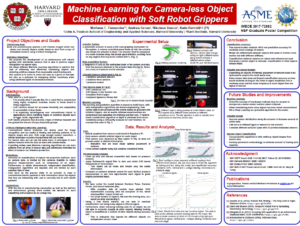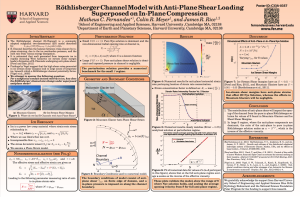Publications - Conference Posters
Publication Types:

Soft Robot Gripper with Camera-less Object Classification using Machine Learning
Abstract
Current automation and soft robotic arms use a collection of cameras and sensors to grab and identify inventory objects in manufacturing as well as distribution centers. However, due to sensing limitations, these systems may not be able to classify objects based on features such as compliance, texture and shape. In this project we explore a new and exciting avenue to classify gripped objects via compliance, curvature and pressure data from embedded sensors in combination with machine learning algorithms. We introduce a soft pneumatic actuator that is able to conform to a desired objects shape and size while continuously providing sensor data from multiple force sensors, curvature sensors and fluid pressure sensors. By acquiring data for multiple pre-classified objects, we develop a training database that is used in generative classification machine learning model. Using the model, we are than able to predict the classification new objects. Furthermore, we validate our model by testing a set of objects for which the classes are known and use similar untrained items to understand the limitations of the model and machinery.

Röthlisberger Channel Model with Anti-Plane Shear Loading Superposed on In-Plane Compression
Abstract
The Röthlisberger channel (R-channel) is a commonly adopted model that balances creep closure by Nye 2D in-plane straining, driven by the ice overburden pressure, against the melt rate from viscous energy dissipation in turbulent flow within the channel. Perol and Rice (AGU abstr. C11B- 0677, 2011; JGR 2014 in review) and Suckale et al. (JGR F003008, 2014) have conjectured that these R-channels may exist at the beds of rapidly straining West Antarctic Ice Stream shear margins. That is expected as a result of melt generation and drainage from forming temperate ice, and the channels may interact through the bed hydrology to partially stabilize the shear margin against lateral expansion. However, at those locations the overburden stresses, driving in-plane flow, are supplemented by substantial anti-plane shear stresses. Similarly, R-channels in mountain glaciers are also subject to both in-plane and anti-plane stresses. These channels usually form in the downstream direction, where anti-plane shear effects arise horizontally from drag at lateral moraines and vertically from the downslope gravity component. Here we examine how superposed anti-plane loading can alter results of the Nye solution for a 2D R channel. We use a combination of perturbation analyses and finite element methods, varying the amount of applied anti-plane stress. A closed-form solution is derived for imposing a small anti-plane perturbation, which has no effect at linear order on the Nye closure rate. Such effects become strong at more substantial perturbations, and the in plane stress and strain fields are then significantly altered from the Nye solution. We further extend our model to compute channel size in terms of the external stressing and flow rate. Understanding the effect of the ice flow on channel size and formation is important to subglacial hydrology, as well as a potentially vital component for our understanding of the formation and motion of ice-streams found in West Antarctica.

Wind Flow Model of Area Surrounding the Case Western Reserve University Wind Turbine
Abstract
The CWRU Turbine is a research turbine located in a urban campus in Cleveland, Ohio. This location may create turbulence, resulting in a possible loss in energy generation. This research attempts to answers the question of whether the wind flow is affected by the buildings or not. The surrounding buildings, which vary in height from 20 to 40 meters, may affect the wind patterns at the hub height. In order to investigate this issue, a CFD model of the immediate area was generated. The analysis using a CFD model includes prevailing wind directions and analyzes the outcomes of the wind flow pattern around the turbine. Reasonable agreement was found when the model was tested and compared against real wind measurements.
